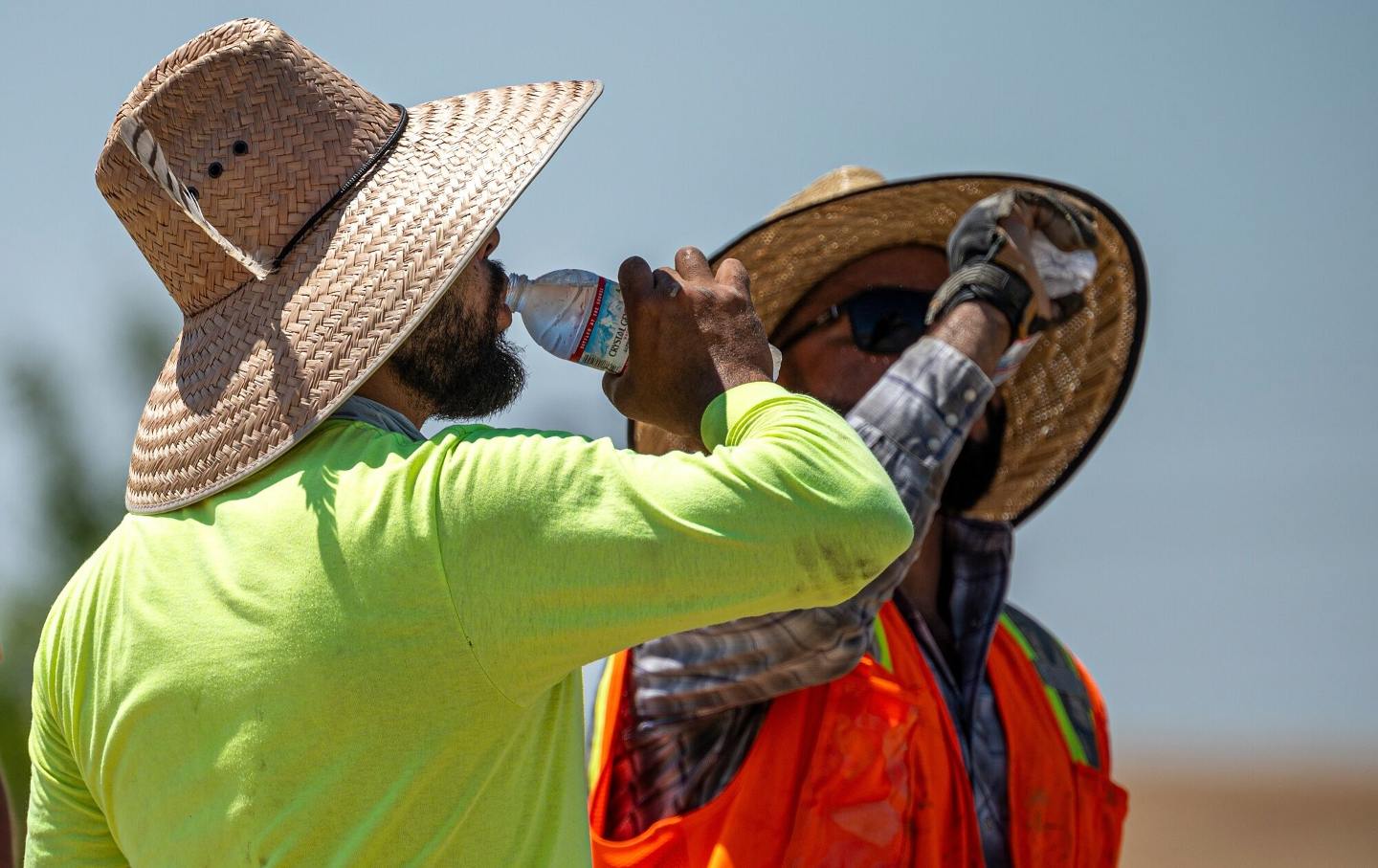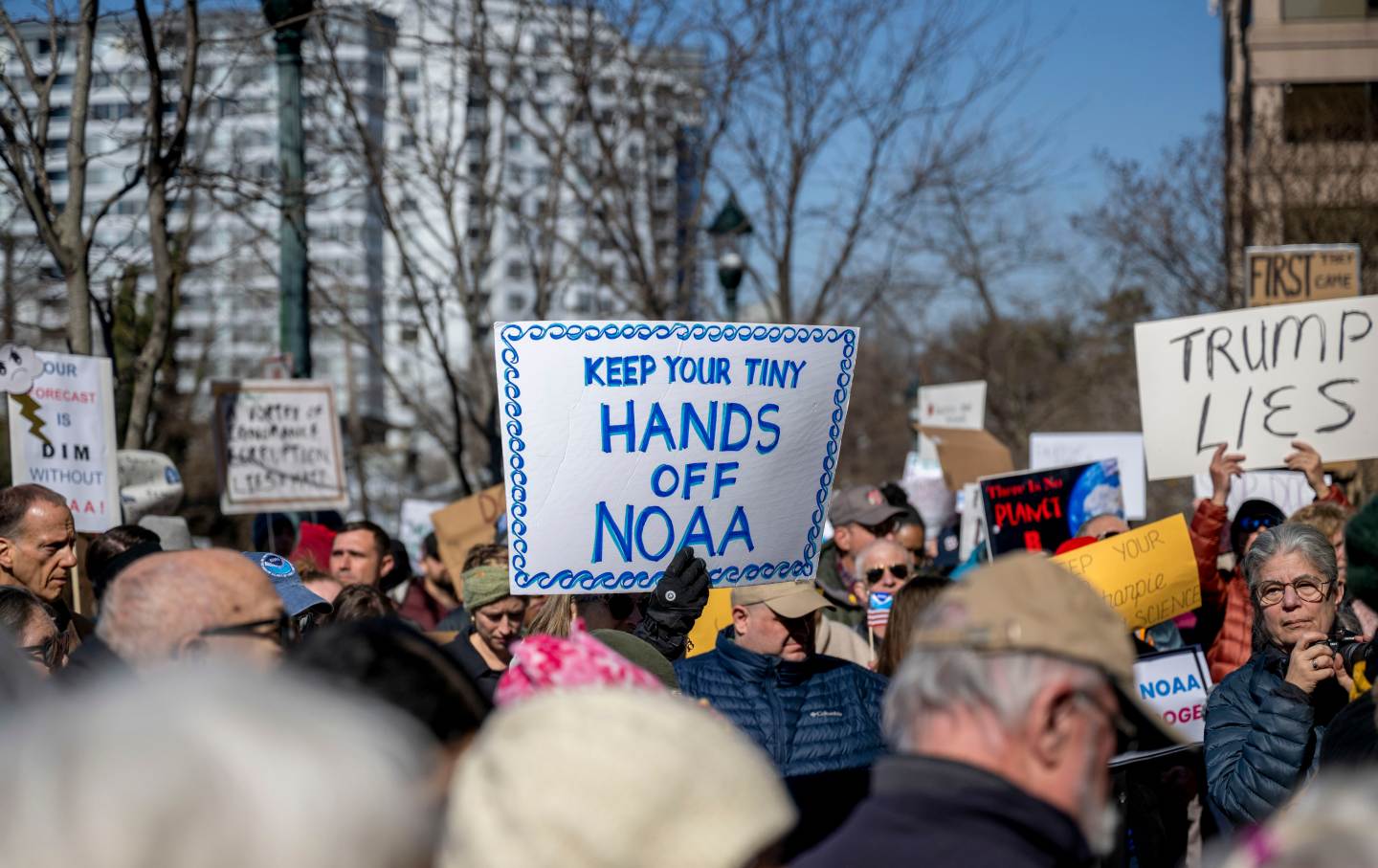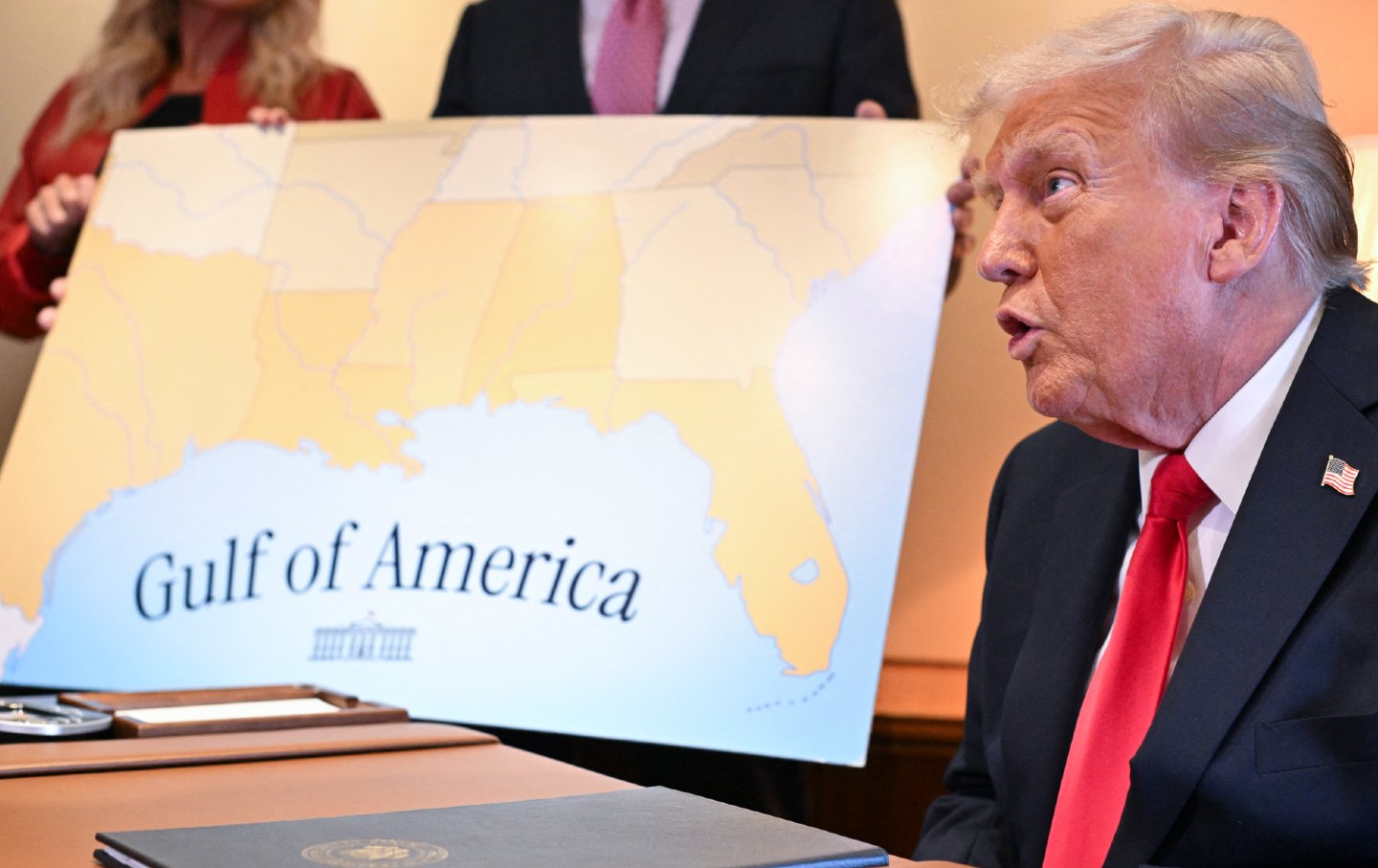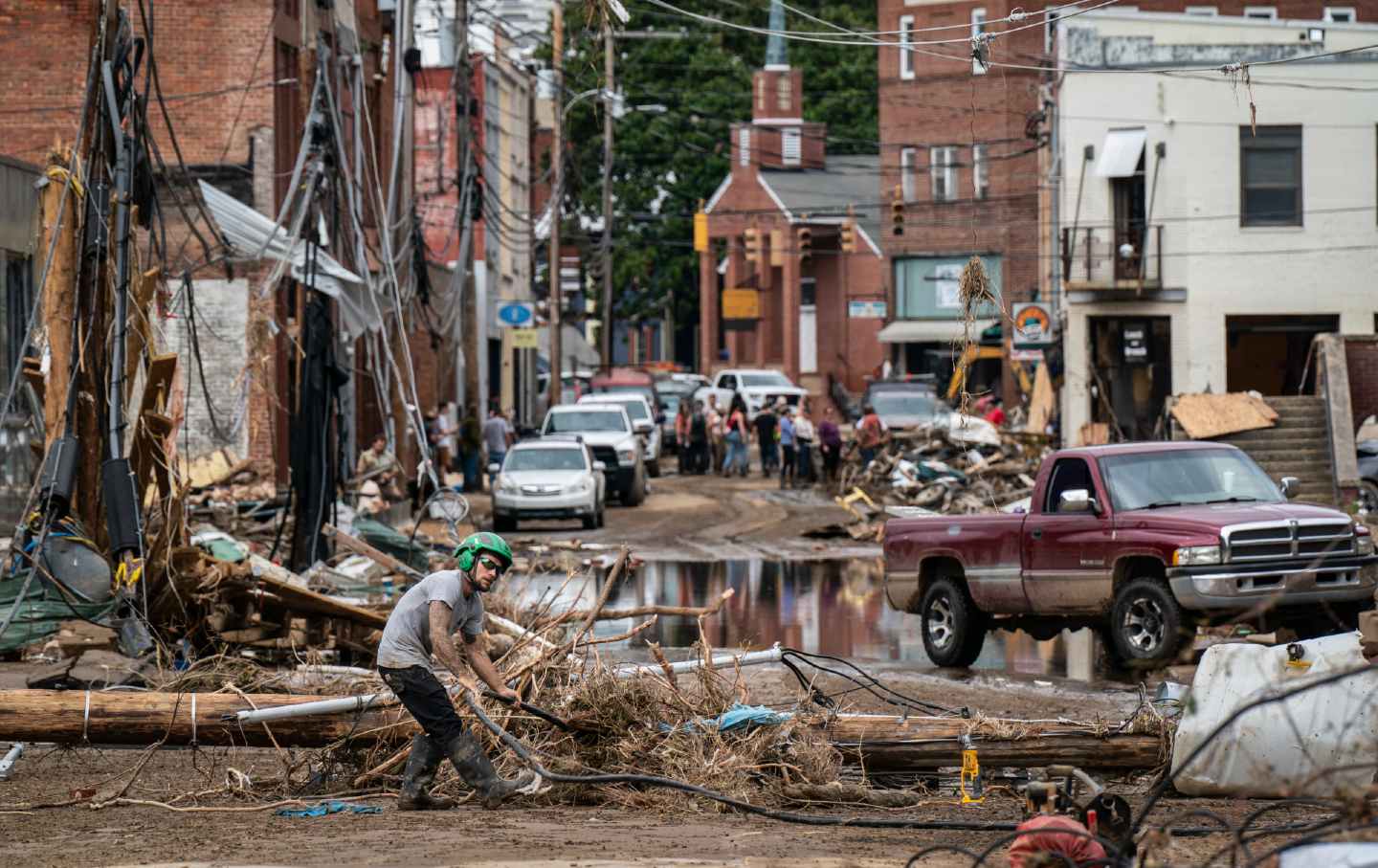A Proposed Regulation Could Protect Millions of Workers From Extreme Heat
As temperatures continue to rise from climate change, OSHA’s first and only extreme heat proposal would help over 36 million people.

Construction workers drink water in Folsom, California, on July 3, 2024.
(Paul Morris / Getty)
For Eva Marroquin, it doesn’t matter how hot it gets. “Either way, we have to put up with the heat. We have to stand it,” said Marroquin, an immigrant laborer, after returning home from a long day at a construction site in Austin, Texas. This week, the high is once again expected to near 100 degrees.
Marroquin has worked on thousands of buildings and homes in the last 18 years, spending her workday painting, constructing, and cleaning outdoor facilities for hours on end. Even when she’s inside, it’s often without air conditioning, access to drinking water, or breaks.
“[Contractors] are very strict, and they don’t respect the laws,” she said. “I suffered from a heat stroke, which hurts your throat so much. I had to go to the doctor, and the doctor said I was dehydrated. Another worker I know went to the hospital because he was passing out. It’s very terrible what happens to you.”
There were more than 2,300 heat fatalities in the United States in 2023—a record for the most heat-related deaths in a year. But 2024 could be even worse. Earlier this month, there were 28 deaths due to extreme heat in a single week.
On July 2, the US Department of Labor’s Occupational Safety and Health Administration (OSHA) proposed a new rule that would protect more than 36 million workers from heat-related illnesses and deaths. Regulations included employers’ responsibility to designate rest time, provide adequate water, and monitor heat-induced symptoms. The rule, “Heat Injury and Illness Prevention in Outdoor and Indoor Work Settings” includes stipulations once the temperature hits the 80-degree or 90-degree mark. “Heat is the leading cause of death among all hazardous weather conditions in the United States,” wrote OSHA. “This is a significant step toward a federal heat standard to protect workers.”
“Temperatures are increasing,” said Dr. Susan Kaplan, a research assistant professor at the University of Illinois Chicago studying Environmental & Occupational Health Sciences. “If you think about someone who works outdoors all day, they are now being exposed to a lot more heat over the course of their work shift than they were maybe five or 10 years ago.”
States like Texas also have no oversight for workers in extreme heat. In 2015, OSHA found the state to be the deadliest for construction workers, with one worker dying every three days. The few protections workers previously had through local and county amendments were overridden in September of 2023 under Texas’s HB 2127, preventing cities from making local ordinances contradicting the state code. Because Texas’s Labor Code doesn’t address water and break access in extreme heat, workers in scorching conditions are left to burn.
David Broyles has been installing and transferring generators across Austin, Texas, since he was a teenager. After 20 years on the job, he says working in the heat has become normal, but that “it’s gotten worse” over time. Broyles, who often does work for the city, says his job sometimes requires working 12 to 16 hours a day outside. “I can’t just leave after eight hours,” he said, as electrical workers must make sure that generators for the city are always working.
“About five weeks ago, I was doing a shutdown in South Austin, and it was a 14-hour day. Around the 12th hour, I got to a point where my fellow workers told me to stop and sit down,” he said. According to Broyles, it is often other coworkers who have to step in and “take care of each other.”
Witnessing coworkers suffer from heat exhaustion is not uncommon, according to Ryan Pollock, an electrician who worked outside for seven years before becoming the politics director for Local 520 of the International Brotherhood of Electrical Workers union.
“We have folks passing out,” he said, and has been on several job sites where people have had medical emergencies due to heat. “There was a guy a couple of months ago who, long before the summer even started, had heat exhaustion. He went home early because he wasn’t feeling well, and ended up passing out in his truck and wrecking.”
Marroquin said that most of her coworkers are undocumented immigrants who work in construction sites off the books. This makes reporting the abuse and getting fairer practices nearly impossible, and many are fearful of retaliation from their contractor.
“It doesn’t just come in the form of exposure to the heat. We’ve had cases where members with green cards go to their supervisor to try to recover their stolen wages, and the supervisor will come back and threaten to have them deported, even though that worker has a work permit,” said Christine Bolaños of Worker’s Defense, an organization that fights for low-wage immigrant workers in Texas. “There’s this stigma in the construction industry that all of them are undocumented, that they can’t speak English, so that makes everyone more vulnerable.”
Broyles and Pollock both work under union agreements. Their contract stipulates that on hotter days, the contractor company must provide cold water, shade, and rest time. For them, the union is the only way they can protect themselves and other workers after the Texas legislature ruled out local laws. “Our state legislature said, “You don’t have to provide water,” which was offensive and dehumanizing,” said Broyles. “There’s little to no recourse. Now it seems like there’s going to be even less in the future. It’s very tough,” adds Pollock. “We can’t count on the government anymore.”
Anthony Carnathan has been a carpenter for over 20 years and is now a union member. He explained the difference in treatment when he worked a nonunion job at the Alabama University’s Bryant–Denny Stadium in Tuscaloosa. “I remember the project manager saying they don’t have Gatorade on site because they didn’t want us flocking and resting around the water keg,” he said. “We all have rights, but you don’t know until people teach you,” Carnathan says of union protections. “We always say, be your brother or sister’s keeper.”
For workers doing hard labor in the sun, the proposed OSHA rule doesn’t go far enough. “It’s the bare minimum of humanity to allow your workers cold water and some type of adequate break system whenever it’s 100 plus degrees outside,” Broyles said. “It seems to be just the bare minimum of ‘Hey, at least we’ll kind of consider you a person, at least enough to give you water.’”
Other organizers see it as one of the only ways workers can secure federal protections. “When you’re in these heat situations, the 15-minute break might not be enough for people. It’s really important to provide protections for the individual,” says Larry Hodge, the senior community engagement coordinator at Jobs to Move America in Birmingham, Alabama. “It could save lives. It’s a great start.”
As conversations move forward in job sites, the chances of the proposal being implemented are slim. After the rule goes into the Federal Register, the public will have the opportunity to provide comments, after which OSHA will finalize a “final rule,” which is sent to Congress and the president. However, with Donald Trump leading the polls, OSHA, an already underfunded agency, could take further hits. At the same time, SCOTUS’s recent rollback of Loper Bright v. Raimondo, the ruling that governs regulatory agencies, is said to impact OSHA.
Popular
“swipe left below to view more authors”Swipe →In a recent report, The Washington Post says that the OSHA proposal “will likely be vulnerable” to being blocked, and Justice Clarence Thomas recently called the authority of OSHA “unconstitutional” and “far-reaching,” which sparked outrage from workers.
The recent overruling of Chevron v. Natural Resources Defense Council further takes away agencies’ right to interpret ambiguous congressional laws, and the conservative supermajority in SCOTUS might now target OSHA’s jurisdiction in the Allstate Refractory Contractors case, which argues that Congress “violated the Constitution by allowing the agency to set and enforce safety standards.”
“SCOTUS is completely captured. We can’t rely on these people,” said Pollock. “They’re going to tear us apart, and they’re working their way to a new feudal system.”
At the same time, workers like Broyles and Pollock believe that organizing efforts and unions might be the only way to keep themselves protected. “I actually became an electrical worker because, ideologically, I wanted to be in a union,” Broyles said. “But most other people that work around do not have that. I use my privilege to provide cold water to other people—painters, plumbers, and anyone else on the job that is working around me that I know that their contractor is not providing them cold water.”
Broyles has gone to work for nonunion contractors to spread the unionist mentality. He said that he often explains to them that in a union “the contractor couldn’t treat you like that, because we have a contract that says they can’t, and they have to provide cold water. If you were working in a union, then these conditions would be bad.”
“We have this extra agreement, and this leverage to ensure that we’re working safely,” Pollock said. “We make sure we’re putting on protections that we need in our bargaining agreement, and if we don’t feel safe, then we’re not working.”
This article includes translated interviews originally conducted in Spanish.
Support independent journalism that exposes oligarchs and profiteers
Donald Trump’s cruel and chaotic second term is just getting started. In his first month back in office, Trump and his lackey Elon Musk (or is it the other way around?) have proven that nothing is safe from sacrifice at the altar of unchecked power and riches.
Only robust independent journalism can cut through the noise and offer clear-eyed reporting and analysis based on principle and conscience. That’s what The Nation has done for 160 years and that’s what we’re doing now.
Our independent journalism doesn’t allow injustice to go unnoticed or unchallenged—nor will we abandon hope for a better world. Our writers, editors, and fact-checkers are working relentlessly to keep you informed and empowered when so much of the media fails to do so out of credulity, fear, or fealty.
The Nation has seen unprecedented times before. We draw strength and guidance from our history of principled progressive journalism in times of crisis, and we are committed to continuing this legacy today.
We’re aiming to raise $25,000 during our Spring Fundraising Campaign to ensure that we have the resources to expose the oligarchs and profiteers attempting to loot our republic. Stand for bold independent journalism and donate to support The Nation today.
Onward,
Katrina vanden Heuvel
Editorial Director and Publisher, The Nation
More from The Nation

Is Mark Carney a Climate Radical? Is Mark Carney a Climate Radical?
Canada’s prime minister–designate backs the science that says most fossil fuel can’t be burned.

Trump’s Deadly Assault on Weather Reporting Trump’s Deadly Assault on Weather Reporting
I’m a meteorologist, and breaking NOAA would undermine journalists’ ability to cover the story our audiences care about most.

Climate Retreat in Germany? Climate Retreat in Germany?
The public still wants action, but elections in the world’s third-biggest economy may stall progress.

The First Amendment vs. the Wannabe King The First Amendment vs. the Wannabe King
What are the climate implications of Donald Trump punishing the Associated Press?

How Journalists Can Stand Up to Trump’s Bluster How Journalists Can Stand Up to Trump’s Bluster
Newsroom layoffs make it harder, but reporters must keep telling the truth about climate change.

The People in Charge Won’t Save Us From Climate Catastrophe. We’ll Need to Do It Ourselves. The People in Charge Won’t Save Us From Climate Catastrophe. We’ll Need to Do It Ourselves.
Grassroots efforts in places like North Carolina show what we can—and increasingly must—do in a world plagued by climate disasters.


